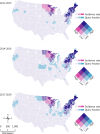Identifying the geographic leading edge of Lyme disease in the United States with internet searches: A spatiotemporal analysis of Google Health Trends data
- PMID: 39535983
- PMCID: PMC11560046
- DOI: 10.1371/journal.pone.0312277
Identifying the geographic leading edge of Lyme disease in the United States with internet searches: A spatiotemporal analysis of Google Health Trends data
Abstract
Background: The geographic footprint of Lyme disease is expanding in the United States, which calls for novel methods to identify emerging endemic areas. The ubiquity of internet use coupled with the dominance of Google's search engine makes Google user search data a compelling data source for epidemiological research.
Objective: We evaluated the potential of Google Health Trends to track spatiotemporal patterns in Lyme disease and identify the leading edge of disease risk in the United States.
Materials and methods: We analyzed internet search rates for Lyme disease-related queries at the designated market area (DMA) level (n = 206) for the 2011-2019 and 2020-2021 (COVID-19 pandemic) periods. We used maps and other exploratory methods to characterize changes in search behavior. To assess statistical correlation between searches and Lyme disease cases reported to Centers for Disease Control and Prevention (CDC) between 2011 and 2019, we performed a longitudinal ecological analysis with modified Poisson generalized estimating equation regression models.
Results: Mapping DMA-level changes in "Lyme disease" search rates revealed an expanding area of higher rates occurring along the edges of the northeastern focus of Lyme disease. Bivariate maps comparing search rates and CDC-reported incidence rates also showed a stronger than expected signal from Google Health Trends in some high-risk adjacent states such as Michigan, North Carolina, and Ohio, which may be further indication of a geographic leading edge of Lyme disease that is not fully apparent from routine surveillance. Searches for "Lyme disease" were a significant predictor of CDC-reported disease incidence. Each 100-unit increase in the search rate was significantly associated with a 10% increase in incidence rates (RR = 1.10, 95% CI: 1.07, 1.12) after adjusting for environmental covariates of Lyme disease identified in the literature.
Conclusion: Google Health Trends data may help track the expansion of Lyme disease and inform the public and health care providers about emerging risks in their areas.
Copyright: © 2024 Wychgram et al. This is an open access article distributed under the terms of the Creative Commons Attribution License, which permits unrestricted use, distribution, and reproduction in any medium, provided the original author and source are credited.
Conflict of interest statement
The authors have declared that no competing interests exist.
Figures


Similar articles
-
The utility of "Google Trends" for epidemiological research: Lyme disease as an example.Geospat Health. 2010 May;4(2):135-7. doi: 10.4081/gh.2010.195. Geospat Health. 2010. PMID: 20503183
-
Lyme Disease Under-Ascertainment During the COVID-19 Pandemic in the United States: Retrospective Study.JMIR Public Health Surveill. 2024 Sep 12;10:e56571. doi: 10.2196/56571. JMIR Public Health Surveill. 2024. PMID: 39264291 Free PMC article.
-
The Influence of Media Coverage and Governmental Policies on Google Queries Related to COVID-19 Cutaneous Symptoms: Infodemiology Study.JMIR Public Health Surveill. 2021 Feb 25;7(2):e25651. doi: 10.2196/25651. JMIR Public Health Surveill. 2021. PMID: 33513563 Free PMC article.
-
[Web search data as health data? : Geographic differences, temporal trends, and topics of interest from internet search engine analyses in Germany].Hautarzt. 2022 Jan;73(1):53-60. doi: 10.1007/s00105-021-04918-x. Epub 2021 Nov 23. Hautarzt. 2022. PMID: 34812913 Free PMC article. Review. German.
-
More than just a stye: identifying seasonal patterns using google trends, and a review of infodemiological literature in ophthalmology.Orbit. 2023 Apr;42(2):130-137. doi: 10.1080/01676830.2022.2040542. Epub 2022 Mar 3. Orbit. 2023. PMID: 35240907 Review.
References
-
- Beard CB, Eisen RJ, Barker CM, Garofalo JF, Hahn M, Hayden M, et al.. Vectorborne diseases. In: The impacts of climate change on human health in the United States: a scientific assessment. U.S. Global Change Research Program; 2016.
MeSH terms
LinkOut - more resources
Full Text Sources
Medical

